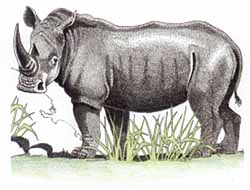English: White Rhinoceros; French: Rhinocéros Blanc; Afrikaans: Witrenoster; Arabic: Um Girin, Abu Gare; Dinka: Mirer; Kiswahili: Faru; Kung: c’hei; Luganda: Emkula; Matabele: Chukuru; Shona: Fura; Shosa: Umkhombe; Sindebele: Mhofu; Sotho: Tshukudu, Mogo hu; Tswana: Kgetlwa, Kôbaôba; Zulu: Umkhombe.
 |
Former distribution: From south-east Sudan to south-east Chad; further south to the eastern African countries, to north-west Uganda and north-east Zaire.
Present distribution: South-west Sudan, Uganda, Zaire and introduced into South Africa.
Behaviour: Preferred habitat: dry open woodlands with good grasslands; predominantly grazers and active both by day and by night: mainly solitary, or in family groups. Predators to the pups are hyenas, lions.
Population status: Endangered. Total: 1000 estimated.
Brief notes:
Body weight: 2000-2700 kg
Head and body length: 370-400 cm
Tail length: 70 cm
Shoulder height: 160-190 cm
Gestation period: 16 months
Maximum age: 45 years
Trophy: Horn length. Record RW’s: 117 1/8 score, 1933, D.N. PAPALIOS; average 80″ score. SCI: 109 6/8″ score, 1985 South Africa, S.A. Trophy Safaris; average 70″ score.
Subspecies: 2
1. Ceratotherium s. simum South Africa: Natal; introduced into Botswana, Namibia, Zimbabwe, Kenya. Endangered (1000).
2. Ceratotherium s. cottoni South-west Sudan, north-east Zaire, Uganda?, Central African Republic? Endangered (200-300).
Remarks: Poaching for its horns is still going on for the northern subspecies, C.s. cottoni. Military operations also led to a drastic decline. In Chad they are already extinct! The southern subspecies, C.s. simum, is again stable, having been well managed by the countries concerned. Their introduction into other regions such as South Africa, Botswana, Zimbabwe, Namibia and Kenya was a complete success.






